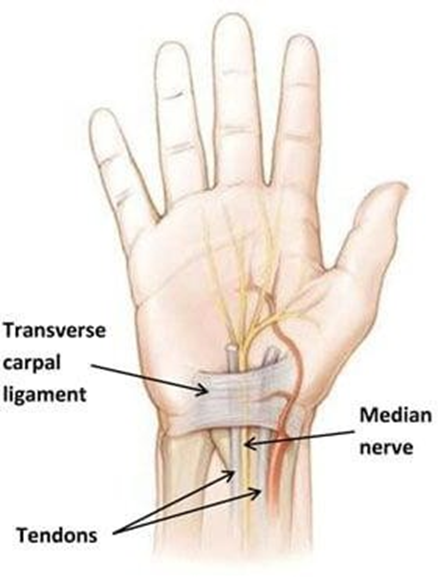The nurse suspects that a client has carpal tunnel syndrome and prepares to conduct the Phalen test. What instructions should the nurse give the client to perform the Phalen test?
Plantarflex the foot
Dorsiflex the foot
Hold both hands back to back while flexing the wrists 90 degrees for 60 seconds
Hyperextend the wrists with the palmar surface of both hands touching, and wait for 60 seconds
The Correct Answer is C
A. Plantarflexion and dorsiflexion refer to movements of the foot and are unrelated to the Phalen test.
B. Hyperextension of the wrists with the palmar surfaces touching is not the correct maneuver for the Phalen test.
C. The Phalen test involves holding both hands back to back while flexing the wrists at a 90- degree angle for about 60 seconds, which may induce symptoms of carpal tunnel syndrome in those affected.
D. Hyperextending the wrists with the palms together doesn’t simulate the stress on the median nerve in the same way as the Phalen test.

Nursing Test Bank
Naxlex Comprehensive Predictor Exams
Related Questions
Correct Answer is B
Explanation
A. Hyperalgesia refers to increased sensitivity to pain stimuli, not specifically related to the inability to feel vibrations.
B. Peripheral neuropathy, a common complication of diabetes, often leads to sensory deficits, especially in distal extremities like the toes and feet.
C. Hyperparalysis is not a recognized term in neurology.
D. A lesion of the sensory cortex would likely present with broader sensory deficits rather than a specific loss of vibration sensation in the distal lower extremities.
Correct Answer is A
Explanation
A firm, irregularly shaped mass found during a rectal examination could potentially indicate a serious condition such as a tumor or other pathology. It's essential to report such findings and refer the client to a specialist for further evaluation and appropriate diagnosis.
B. It's important not to dismiss or downplay the significance of finding a mass, as it could signify a serious health issue.
C. Waiting a month for reassessment could potentially delay necessary medical intervention if the mass is concerning.
D. While documentation is important, it's crucial to prioritize immediate reporting and referral for further evaluation when such findings are discovered.
Whether you are a student looking to ace your exams or a practicing nurse seeking to enhance your expertise , our nursing education contents will empower you with the confidence and competence to make a difference in the lives of patients and become a respected leader in the healthcare field.
Visit Naxlex, invest in your future and unlock endless possibilities with our unparalleled nursing education contents today
Report Wrong Answer on the Current Question
Do you disagree with the answer? If yes, what is your expected answer? Explain.
Kindly be descriptive with the issue you are facing.
